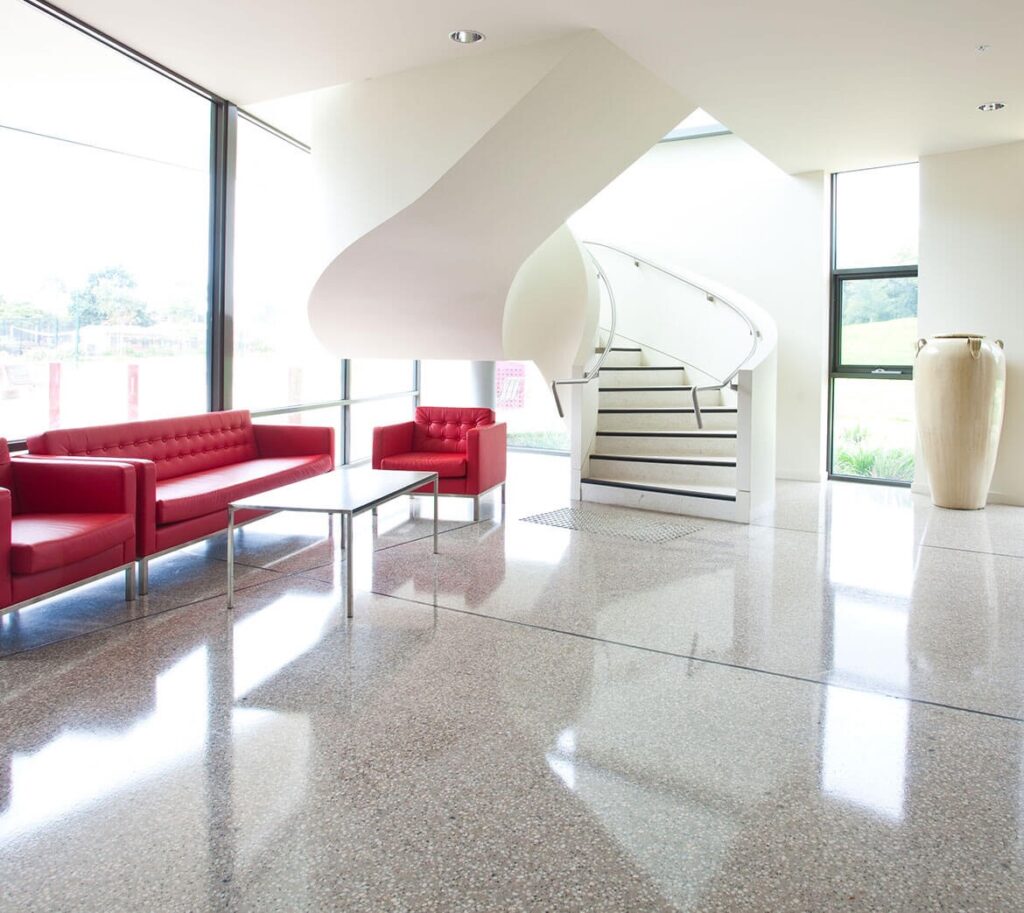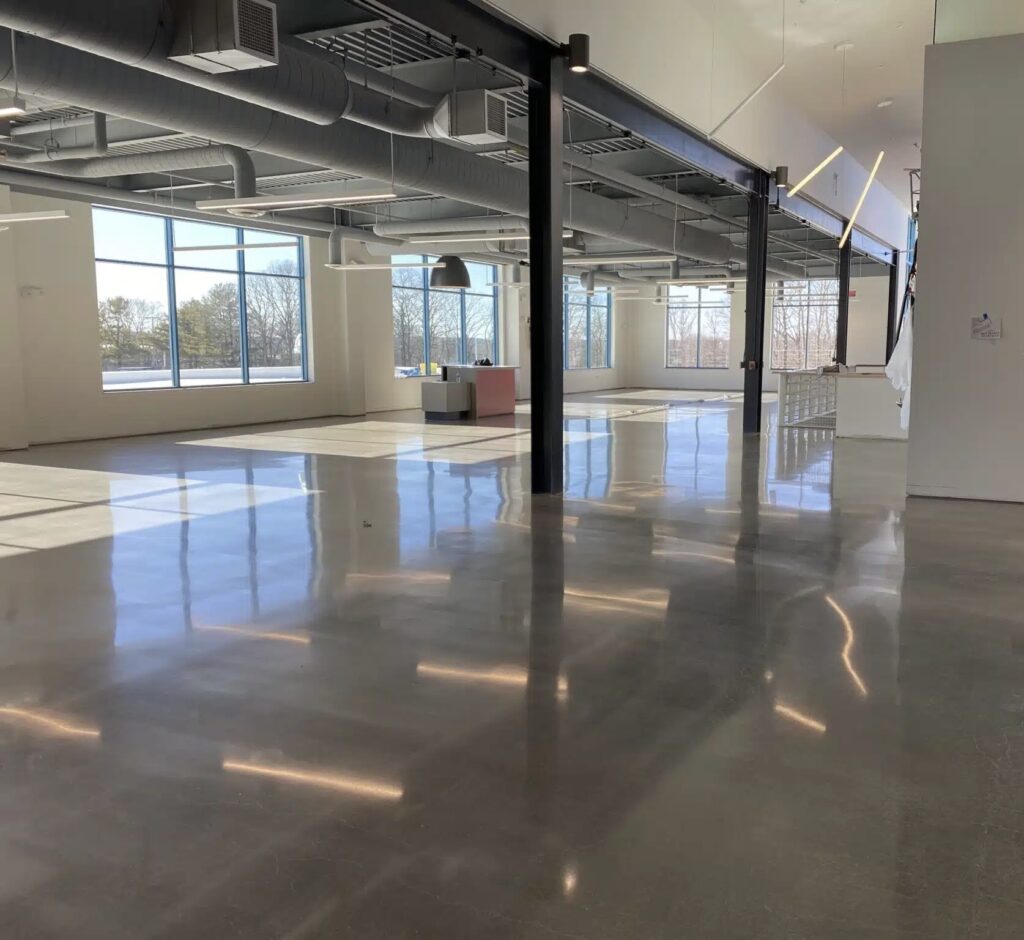
The UK’s leading resin flooring specialist
Concrete Polishing
Concrete polishing is a highly effective process that transforms plain concrete surfaces into durable, aesthetically pleasing finishes suitable for various environments, including warehouses, workshops, and retail spaces. This flooring solution enhances the concrete’s visual appeal and significantly improves its durability and functionality.
The Polishing Process
The concrete polishing process begins with an initial grind using coarse diamond grinding tools. This first step is essential for removing surface imperfections such as old coatings, stains, and blemishes. It prepares the concrete for subsequent grinding and polishing stages, ensuring a flat surface. Typically, the grinding is performed in stages, each utilising increasingly finer grits of diamond tools, allowing for greater precision and smoothness.
As the grinding progresses, you’ll encounter various levels of finish, often categorised by a scale labelled by some equipment manufacturers as bronze, silver, gold, and platinum. This scale reflects the increasing sheen and refinement that each successive stage achieves. For example, a bronze finish may have a more matte appearance. In contrast, a gold finish often boasts visible aggregate and a high gloss, showcasing the beauty of the concrete and creating a more sophisticated look.
The next step involves densification after achieving the desired grind and aggregate appearance. During this stage, a chemical densifier—typically a liquid compound—is applied to the surface of the concrete. The densifier penetrates the concrete, which enhances its overall density and durability. This treatment makes the surface more resistant to wear and tear and minimises its porosity, reducing its susceptibility to stains and moisture penetration.
Once the surface has been adequately densified, the final stages of polishing commence. Here, finer diamond pads are used to create a high-gloss finish, which brings out the natural beauty of the concrete and results in a stunning, reflective surface. This polished finish is attractive and functional, enhancing the overall ambience of the space.
To conclude the polishing process, a semi-impregnating seal is applied. This seal serves multiple purposes: it protects the polished surface from scratches and stains, enhances its resistance to moisture, and ensures that the polished finish maintains its shine over time. The semi-impregnating nature of the seal allows it to penetrate the surface, creating a bond that does not make a barrier but works in harmony with the densified concrete.

Environmental Benefits
Choosing polished concrete for your floors comes with a multitude of environmental advantages. One of the primary benefits is sustainability; polished concrete utilises existing concrete slabs, reducing the need for additional materials and minimising waste. This conserves natural resources and reduces the carbon footprint of producing and transporting new flooring materials.
Moreover, polished concrete surfaces have a reflective quality that can enhance ambient lighting in your facility. By maximising natural and artificial light, polished concrete can save energy, reducing the need for excessive lighting solutions. This can lead to lower utility bills and a decreased environmental impact, making polished concrete an eco-friendly choice for modern spaces.

Cost Considerations
While the initial investment for polished concrete can be higher than options like epoxy paint, it is essential to consider the long-term value it offers. Polished concrete is not just a surface treatment but a durable flooring solution that can last decades with minimal maintenance. Unlike epoxy, which may require frequent recoating due to wear and damage, polished concrete maintains its appearance and integrity over time.
The lower maintenance costs associated with polished concrete—chiefly due to its ease of cleaning and the absence of regular refinishing—allow businesses to recoup their initial investment relatively quickly. Additionally, the enhanced durability means fewer repairs or replacements are necessary, further improving cost-efficiency. Overall, while the upfront cost may be higher, the long-term savings in maintenance and replacement make polished concrete a financially sound investment.

Practical Advantages
In addition to its environmental benefits, polished concrete is recognised for its practical advantages in commercial and industrial settings. One of its standout features is its slip resistance. Concrete surfaces can provide excellent traction when adequately polished, reducing the risk of slips and falls in high-traffic areas. This safety feature makes it ideal for environments where quick movements and heavy machinery are every day.
Another significant advantage is the ease of maintenance that polished concrete offers. The smooth, non-porous surface minimises dirt and grime accumulation, meaning regular cleaning requires less effort and fewer resources. A simple dust mop or occasional damp mopping can keep the floors pristine, significantly reducing the need for harsh cleaning chemicals and labour-intensive scrubbing.

Ready to Upgrade Your Floor?
In summary, polished concrete is an exceptional resin flooring solution that combines beauty, sustainability, and practicality. From the initial grinding through to densification, polishing, and sealing, the meticulous process results in a visually striking, durable surface that is easy to maintain. With varying finish levels available to suit any aesthetic preference, polished concrete can enhance the efficiency and appeal of any space, making it a smart choice for warehouse floors, workshops, and retail environments. Over time, its long-lasting nature and reduced maintenance costs mean choosing polished concrete can be more economical than cheaper alternatives such as epoxy paint.
FAQs
How long does concrete polishing take?
The time it takes varies depending on the size and condition of your floor. Most projects wrap up in a few days.
Is concrete polishing a cost-effective flooring solution?
While the initial cost might seem higher than some other options, it’s important to consider the long-term value. Polished concrete is exceptionally durable and requires minimal maintenance. These factors translate to significant savings over time.
Can all concrete floors be polished?
Most concrete floors are suitable candidates for polishing. However, the existing condition of the floor can influence the final outcome. Floors with extensive damage might require additional preparatory work before polishing can begin.
What maintenance is required to keep a polished concrete floor looking its best?
Keeping your polished concrete floor looking beautiful is surprisingly easy. Regular dust mopping to remove dirt and debris is essential. Use a damp mop with a pH-neutral cleaner specifically formulated for concrete for occasional deeper cleaning.
Is concrete polishing environmentally friendly?
Polished concrete offers several environmental advantages. It utilises existing materials, minimising construction waste. Additionally, it promotes improved indoor air quality by reducing potential allergens and dust mites, making it a sustainable flooring solution.
REQUEST A CALLBACK
Contact Us
"*" indicates required fields
For bespoke industry flooring solutions talk to Impact Flooring today.
We offer free no obligation advice and can provide a price range on the first call.
Impact House, Short Street, Nuneaton, Warwickshire, CV10 8JF